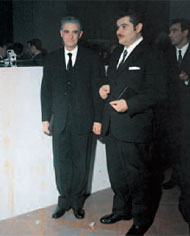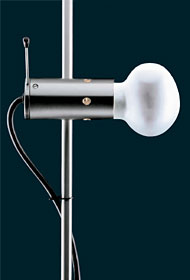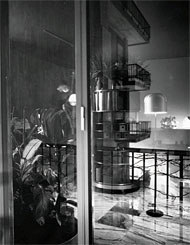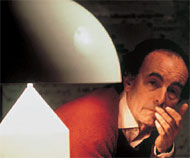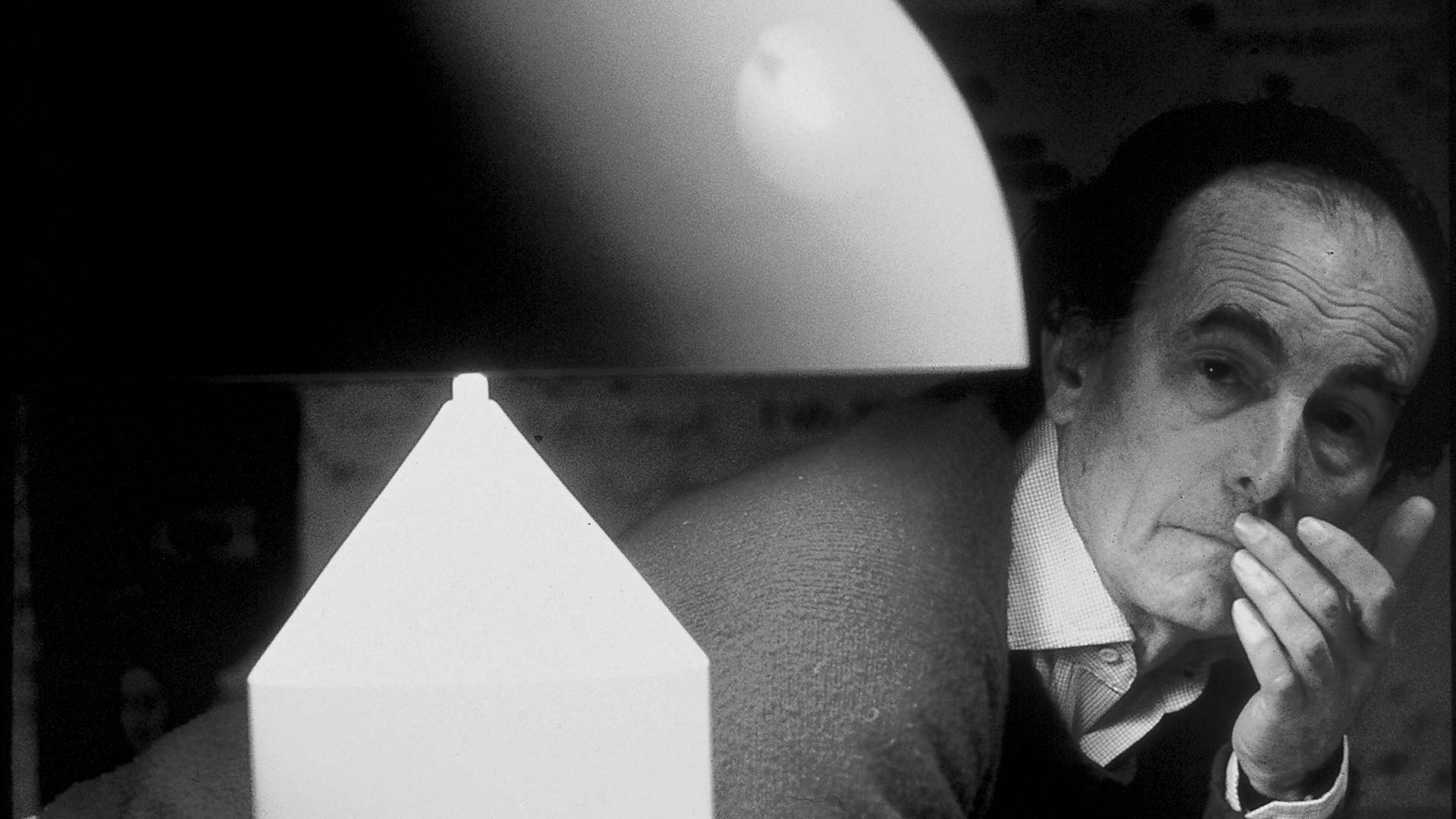
STORY
Founded in 1945 by Giuseppe Ostuni, Oluce is the oldest Italian design company still operating in the lighting world, a unique production excellence which translates passionate aesthetic and technological research into the potential of light into actual form. Over the years, Oluce has succeeded in building a collection structured like a tale, rich and multifaceted, inhabited by products that transcend fashion to become Italian design icons.
Its relationship with the design world begins
In 1951, Oluce successfully took part in the IX Triennale, presenting – in the lighting section curated by Achille, Livio and Pier Giacomo Castiglioni – a Luminator designed by Franco Buzzi. As was typical at that time, the company instantly gained visibility on the international panorama thanks to Domus magazine. Major success was then reasserted by Tito Agnoli with nominations at the second edition of the Compasso d’Oro awards, in 1955, for his two lamps (the 363 floor lamp and a special bookshelf model). In 1956 these were followed in rapid succession by two more nominations: one for a remarkable table lamp in polyvinyl slats and another for a pendant lamp (mod. 4461) with double perspex shade. Then, there was the noteworthy 255/387 lamp (known as ”Agnoli”), a spot light supported by a slender stem, which in 1954 marked the decline of lampshades and the adoption of highly simplified floor lamps even for home lighting.
The great Masters
In addition to Agnoli, Ostuni also worked in collaboration with Forti, Arnaboldi, Monti and Minale. But it was at the end of the 1950s, and specifically thanks to an encounter with Joe and Gianni Colombo, that Oluce took a more pronounced revolutionary direction. The Colombo brothers (only Joe would subsequently continue with his forays into the world of objects, with Gianni devoting himself to pure art) were looking for a stakeholder capable of reacting to their bold designs: and they found it in Ostuni. That alliance produced the 281 table lamp, known as ”Acrilica”, a very thick perspex curve along which the light seems rise, included in the Oluce catalogue since 1962. The 281 stands both as a possible meeting point between art and design, as well as proof of elegant use of innovative materials. Winner of a gold medal at the XIII Triennale, where Joe Colombo would also obtain two silver medals (for the ”Combi-Center” and the ”Mini- Kitchen”), ”Acrilica” put the figure of Joe Colombo up there with the greatest interpreters of that era.
In 1963, Marco Zanuso designed the 275 table lamp for Oluce, with a large white perspex shade on a painted metal base, which entered into production in 1965. In 1964/66, again a new material, ”Fresnel Lens” compact glass, inspired Joe Colombo to design the ”Fresnel” family of weatherproof outdoor lamps, with a painted metal base and shade attached with steel clips. This was followed, in 1965, by the ”Spider” group, where a single lighting fixture, designed for a special horizontal spot light, could be mounted, thanks to a melamine joint, in different settings (home/office) and on different supports (table/floor/wall/ceiling), reiterating the same “family” concept of lamps. In 1967, ”Spider” won the first Compasso d’Oro award for Oluce and was presented in New York in 1972 at the unforgettable exhibition ”Italy: the New Domestic Landscape”.
In 1967, Colombo had already moved on, and with the ”Coupé” model, now on display at the MoMa in New York, designed a large curved stem supporting an extremely elegant semi-cylindrical shade. The design won, the 1968 ”International Design Award” presented by the American Institute of Interior Designers in Chicago. In 1970 the ‘Halogen Lamp’ was born and it has been called by default ‘Colombo’ from then on. It has been the first halogen lamp on the lighting market, becoming an incomparable design icon, functional and contemporary at the same time.
Magistretti and the transfer to the Verderi family
The 1970s saw the beginning of a new and highly important era for Oluce, which coincided with the transfer of ownership from Giuseppe Ostuni to the Verderi family, and was marked by the influential figure of one of the great Italian design masters: Vico Magistretti.
For many years, Magistretti would be the company’s art director and leading designer, leaving his unmistakable mark on the same as well as a legacy of worldwide recognition. Kuta, Lester, Nara, Idomeneo, Pascal, Dim, Sonora, Snow and particularly Atollo, became names that would instantly call to mind their corresponding products. Atollo became a template, a graphic silhouette capable of suggesting the very concept of ”lamp”. Inimitable, though copied the world over, it won the 1979 Compasso d’Oro award and took its place in the permanent collections of the world’s leading design and decorative art museums, becoming so much more than just a lamp: an icon.
Towards the end of the second millennium
At the beginning of the ’90s, the rigor of the Swiss Hannes Wettstein co-existed in tandem with the ironic provocations of Riccardo Dalisi, to broaden what was an expressive and sophisticated catalogue. In 1995, Oluce took a new direction which heightened the collection’s international success and critical acclaim. The new formula focused on expressing extremely different and personal languages, particularly those of the leading exponents in contemporary experimentation such as the English Sebastian Bergne, Italians Laudani&Romanelli, the production of the brothers Fernando and Humberto Campana, poetic narrators of their fare-away Brazil, and the architect Toni Cordero.
The 2000s and Oluce’s contemporary interpretation of the past, present and future.
The contemporary nature of Oluce brings together the past, present and future, tying them together to form an evocative and designed collection, where geometry of forms is completed with unusual materials and precious finishes.
The new millennium confirms and continues the search for interpreters, voices and hands capable of finding different ways to present lighting in line with the company philosophy.
Next to the legacy left behind by the great design masters, partnerships continue with internationally famous designers, an emblem of the contemporary face of Oluce. The refinement of the Japanese Nendo, the poetic minimalism of Toshiyuki Kita, the clean language of Gordon Guillaumier, Carlo Colombo and Lutz Pankow, the expressive experimentation of Francesco Rota and Ferdi Giardini are added to the intuition of Sam Hecht, Jörg Boner and Angeletti Ruzza, right down to the company’s more recent designs by Nicola Gallizia, Victor Vasilev and Christophe Pillet, which contribute to defining the visual grammar of the company by creating lamps that are also sophisticated furnishing elements.
The company’s contemporary vocation is also interpreted, with a close eye on the future, through the intuition of young designers like the Italian-Japanese duo Mist-o – with the sculptural lamp LAS – or the students from Rome’s IED, Mariana Pellegrino Soto and Francesca Borelli, whose products, originally designed for their university thesis and presented at Euroluce 2017, are now very much part of the company catalogue.
New standard products and collections are joined by Bespoke Tailoring, the customisation service which Oluce launched in 2015 to cater for the contract sector. Bolstered by its long history in production and with the desire to enhance its human and creative knowledgebase, the company decided to put its lighting experience at the disposal of current market needs. Specially designed lamps or modular versions of pre-existing designs as well as standard products make up the vast and varied tailor made range which the company offers to meet, in the best possible way, the needs of large and small suppliers.
